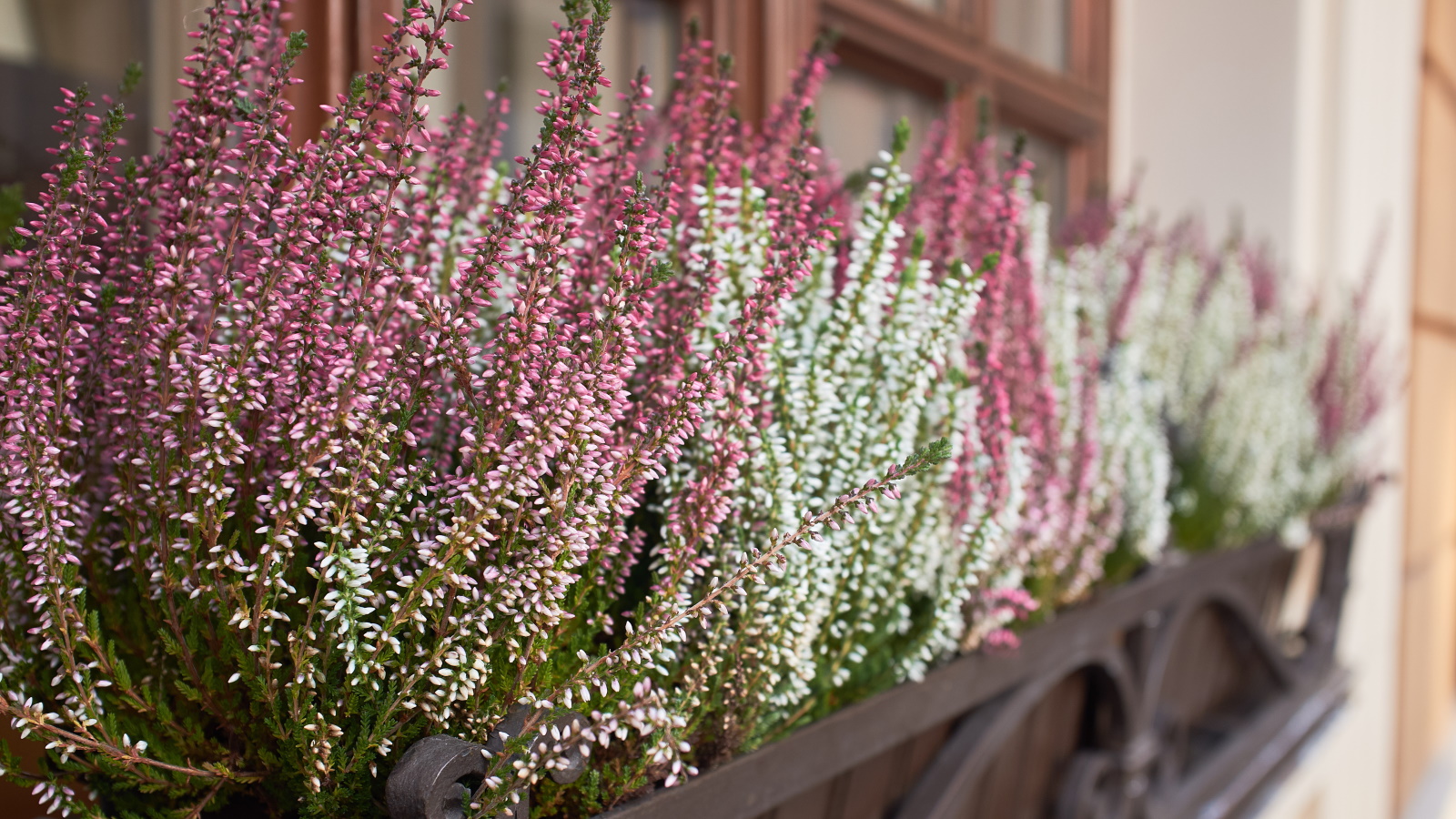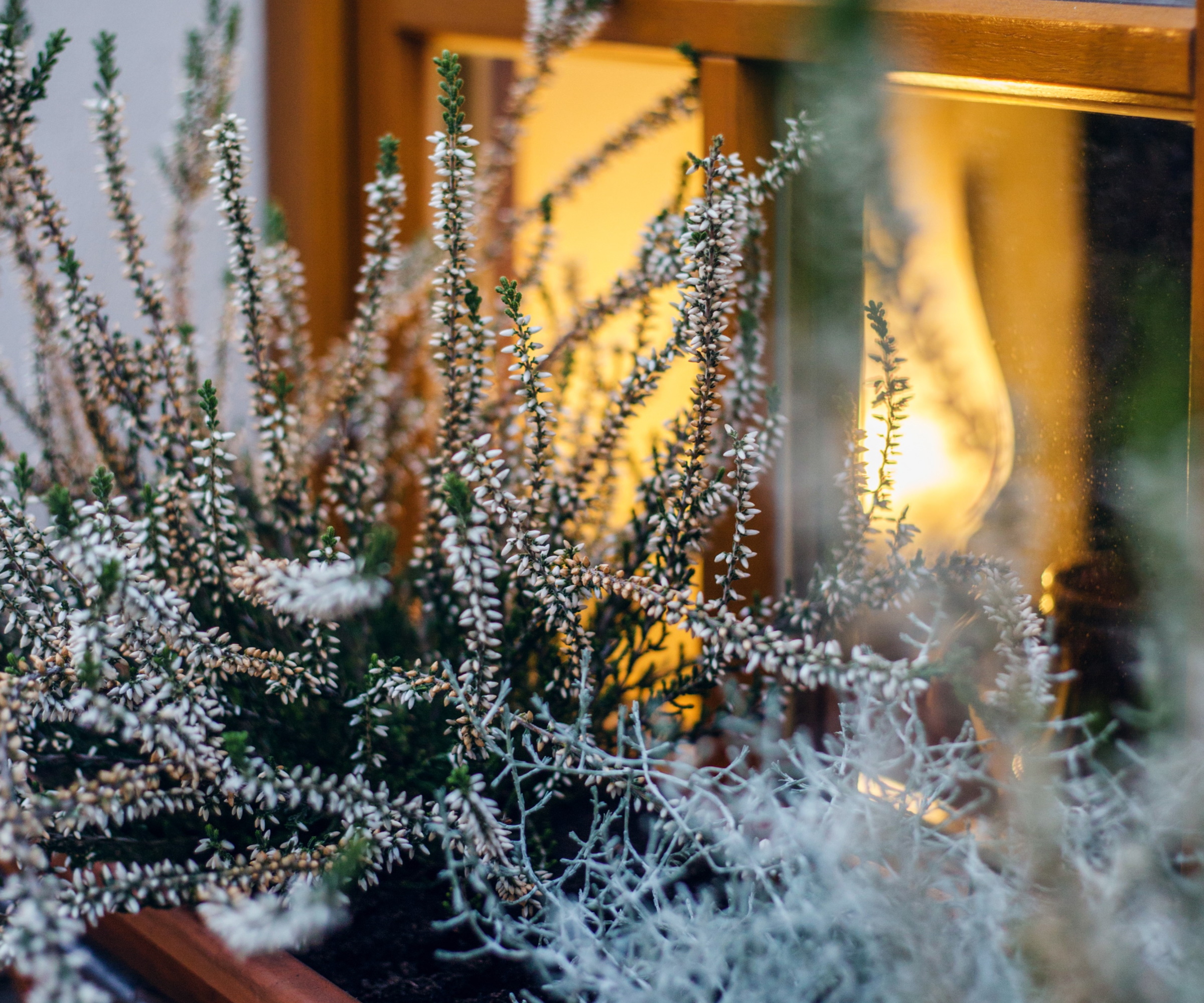
Brighten up your home this winter with an impactful winter window box. Whether you like bright and blousy combinations or a more restrained and verdant look, window boxes are a quick and easy way to be creative and style your windowsills this winter.
By selecting certain winter plants for pots and borders you can add interest to your garden at an otherwise gloomy time of year. When considering what to grow in a window box, firstly determine which plants will tolerate the conditions in your hardiness zone. You can then decide which plants will survive, but also which will match your color, shape and texture preferences. This will help you to create a long lasting and spectacular display that looks good from the outside, and is also visible from the warmth of indoors.
An empty windowsill will not boost your mood, but one that is full of plant life and color might just lift your spirits. Follow our guide below to create your own winter display.

How to create a winter windox box
An impactful window box can add interest to your home this winter. Follow our top tips to create a long lasting and colorful display.
Things to consider when planting a window box

You may already have an empty window box that is ready to use, or perhaps you have purchased a new one. If you are buying new, choose a frost-proof material, such as frost-proof terracotta or recycled plastic, where possible. Ensure that your window box is the right fit for your windowsill, measuring before purchasing to avoid having a container too big or too small for your space. You may also need to secure your window box, if there is any risk that it might fall.
The intended location of your window box is an important consideration. 'Place your window box where it will get as much light as possible during the colder and darker months in winter,' says Drew Swainston, gardening expert and content editor at Homes and Gardens. 'This will keep your plants healthy and give them the best chance of survival.'
It is important to make sure that your container has a drainage hole, preferably more than one. Some plastic containers may require you to carefully puncture a few small holes, so be sure to check this before you fill with soil. Drainage holes are crucial for ensuring that water does not sit in the container. This is a concern in winter, when sitting water can freeze and cause irreparable damage to your plants.
'Ensuring that your containers have adequate drainage is important,' says Drew. 'Incorporating a layer of grit at the base of your container will help, as will using a soil mix that is relatively free draining.'
How to prepare your window box
- Ensure that your container has one or more drainage holes.
- Cover drainage holes with stones or old, broken bits of terracotta to prevent the soil from clogging up the drainage hole.
- Use horticultural grit as a drainage layer at the base of the container, no more than an inch.
- Mix up a free draining potting soil, using a bag of multi purpose compost and a few handfuls of grit and/or sand.
- Once ready, fill the container until you are a few inches from the top, ready for planting, keeping some of the mix back to fill around your plants.
Weather resistant window box, made from a high-grade Polyethylene and with a built-in water reservoir.
Our top plant picks for your winter window box

It is important to plant for instant impact. Remember that the plants you select will grow little, if at all, during winter, so it is always best to use plants that are a good size already. Opting for smaller plants in the hope that they will grow is a sensible thing to do in the summer months, but in winter, it is not an effective approach.
The climate will determine what you are able to plant, dependent on your hardiness zone. We have selected eight plants that are relatively hardy and provide winter interest, helping you to create an impactful window box display.
1. Lenten rose

The Lenten rose, Helleborus x hybridus, is among the first flowers of the year, bearing blooms in a vast array of shades from white and cream to vibrant pink and black.
You needn't be worried about how to grow hellebores, for this winter flowering plant is remarkably tolerant of most conditions, other than drought or water logged soil. Hellebores tend to grow on the edge of woodlands, so most species and varieties are shade lovers, but in winter, they will tolerate an open position.
2. Golden fern

Dryopteris affinis is an evergreen fern consisting of tall, pale green fronds. This fern will provide height and structure, and make a decorative addition to your container.
Most ferns will mix well with other plants in containers, providing the green structure that other, more showy plants can punctuate with colorful blooms. When you're considering how to grow ferns, most like shady, moist conditions.
In a window box, there is little risk of them scorching or drying out in winter, but this is a concern when the temperatures rise.
3. Maidenhair vine

Muehlenbeckia complexa is an unusual plant. Grown for its delicate-looking circular foliage, this plant will create a green and unique look in a container, helpfully covering the soil at the base with a carpet of green.
It is better to grow the maidenhair vine in a container, such as a windowbox, as it does have a tendency to scramble and climb, which can be managed in a container. Tolerant of most conditions, this plant is easy to grow, and will thank you for the occasional drink of water.
4. Winter heather

The small, evergreen winter heather, Erica carnea, will add color and interest to your container all the way through the winter months. The dainty flowers that line the stems go on to flower for many months, ensuring that even in winter, you have flashes of purple, pink and white.
Importantly, winter heather (or winter heath as it is also known) provides food for pollinators in the colder months. Avoid planting in total shade, as this plant does enjoy the sun. Why not plant winter heather with a good foliage plant, such as Sarcococca confusa, for a combination of lush green foliage and colorful flowers.
5. Rosemary

Adding a herb to a windowbox is a great way to add scent to your displays. Even in winter, Rosmarinus officinalis, is a fragrant option, with delicate and interesting foliage.
Considering how to grow rosemary, remember that this plant is native to the Mediterranean, so it should ideally be positioned in a sunny, sheltered spot. As long as your container is free draining, rosemary will survive just fine. It is also relatively frost-hardy, which for the winter months, is helpful.
6. Ivy leafed cyclamen

Commonly used, and for good reason, Cyclamen hederifolium is a great option for including bright flashes of color in your container during the winter months.
There are many types of cyclamen, and many will do well if grown in a window box. Cyclamen are native to mountainous, alpine areas, and so need a free draining soil. You can find white, pink and even red flowering varieties to suit your preferences.
Why not pair with a foliage plant such as bay, Laurus nobilis? The combination of aromatic foliage and dainty flowers will work well in a window box.
7. Sweet box

The glossy green leaves of Sarcococca confusa are reason enough to include this plant in your containers. On top of that, the inconspicuous creamy-white flowers have a wonderful sweet scent, with many considering them one of the best fragrant flowers.
This compact evergreen will go on to produce attractive black berries later in the season. This plant is a shade lover, so avoid planting in full sun.
8. Bay

Another evergreen herb, Laurus nobilis, is an aromatic addition with the attractive bay leaf, perfect for balancing out the flashes of color in your containers. Although we are used to seeing larger specimens of this evergreen shrub, such as in topiary or hedging, smaller pot sizes are available and work well in a container.
Bay should be planted in a free-draining soil, in a sheltered spot. It is best to keep this plant out of strong winds. Why not pair this herb with a flowering plant, such as cyclamen, or some winter flowering bulbs, such as snowdrops?
How to select plants for your window box
- Decide which plants are suitable for your location, using the right plant for your hardiness zone.
- Limit your color palette to shades of green and one other color, such as white or pink.
- Use a mixture of heights and different textures to create the style you want.
- For example, the structure and form of a fern, such as Dryopteris affinis, could be paired with a trailing plant, such as the scrambling Muehlenbeckia complexa; this mixture of tall and hanging plants will create impact.
- Punctuate evergreens with flowers, such as a white variety of Cyclamen hederifolium and/or a white variety of Helleborus orientalis.
- Use plants that will create instant impact in a size suitable for your container.
- Plant in odd numbers and randomly allocate your plants, with taller specimens towards the back.
- Avoid planting in blocks to create a naturalistic look.
How to care for your window box
Once you have planted up your window box, you can sit back and enjoy the fruits of your labor. Your window box should be fairly hardy and low maintenance.
Water your window box sparingly in winter. Overwatering is a risk in the colder months. However, you should check on the soil regularly as it can soon dry out in mild spells, particularly as window sills tend to be covered and so receive less rain water.
It is not necessary to feed window boxes during the winter, as most of the plants you will choose are not actively growing. Once winter is over, and you are considering updating your window boxes, you can replant the contents in your back yard, bulking up your borders for next year.
Mintra window box in grey, with a minimalist design. Includes water tray for overflow.
FAQs
Can I plant bulbs in a window box?
Yes, planting winter flowering bulbs in a window box is a great idea. Early flowering daffodils and hyacinths are just two of the many options. Many miniature bulbs will also be suitable for smaller containers. Ensure that you protect bulbs from squirrels and other garden pests.
When is the right time to plant a winter window box?
You can plant a window box at any time, using plants that are hardy and will tolerate the conditions in your locality. Remember to use plants that will create instant impact in winter, as plant growth slows/stops during the winter months.
Why not consider other frost hardy plants to complement your winter window box and add interest to the borders in your back yard? By adding color and structure, you can brighten up your home through the winter months.







